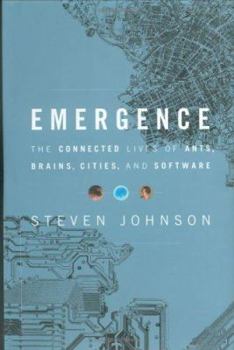Emergence: The Connected Lives of Ants, Brains, Cities and Software
Select Format
Select Condition 
Book Overview
In the tradition of Being Digital and The Tipping Point, Steven Johnson, acclaimed as a "cultural critic with a poet's heart" (The Village Voice), takes readers on an eye-opening journey through... This description may be from another edition of this product.
Format:Hardcover
Language:English
ISBN:068486875X
ISBN13:9780684868752
Release Date:August 2001
Publisher:Scribner Book Company
Length:288 Pages
Weight:1.25 lbs.
Dimensions:1.0" x 6.4" x 9.6"
Related Subjects
Computer Science Computers Computers & Technology Engineering Environmental Engineering Historical Study & Educational Resources History History & Philosophy Mechanical Physics Politics & Social Sciences Science Science & Math Science & Scientists Science & Technology Social History Social Science Social Sciences Sociology System Theory Technology Textbooks UrbanCustomer Reviews
3 ratings
The principles of emergent phenomena explain much in life
Published by Thriftbooks.com User , 19 years ago
As a researcher who studies dynamic systems, the topic of emergent properties is very much of interest to me. The first thing I thought when I read the book was how it applied to so many different phenomena in life. Societies, economies, even psychology and the soul. Yes, the soul - it seems reasonable to me that if we are to postulate the concept of a soul for each of us, could we not look at it as an *emergent* property of our brains? Emergent phenomenon explain much in biology, neurology, genetics and immunology. Give a system many interacting parts, some relatively simple rules for interaction, and voila - a system that behaves in a complex manner despite the underlying simplicity. This book is highly accessible to the layperson and I recommend it to everyone looking for general, guiding principles in understanding life and behavior - including our own. Just read the book and think about how it applies to so many different things. Especially recommended for philosophers and scientists.
must read for general audience
Published by Thriftbooks.com User , 21 years ago
Steven Johnson does a terrific job introducing a complex, scientific theory to a general audience. My sense is that the less glowing reviews of Emergence have been written by people who already knew about the basic theories behind the concept of emergence. For those of us who have not thought much about networks and bottom-up organization (that is, the majority of readers), this book challlenges us to rethink the world around us. And the writing is strong and lively so that readers who ordinarily don't read about scientific theories are welcomed. I hope the audience for whom this book was written--the poets, the teachers, the commuters, and so on--find this book. In the wake of various books that seek to pin down a theory of everything (including E. O. Wilson's Consilience) and in conjunction with other new books on related topics (including Barabasi's Linked), this book leads readers to interesting ways to understand the big questions about how people, ants, or computers work together without really trying. Emergence suggests various big questions: Who are we as individuals if, together, we form networks with emergent behavior? What exactly is consciousness or intelligence if our brains are defined by emergent behavior? Is power in numbers more complex and even more powerful than we had imagined?
A great introduction to organized complexity!
Published by Thriftbooks.com User , 21 years ago
Emergence was a very fast an enjoyable read, using great examples and metaphores to introduce the study of organized complexity. While maybe a little heavy on the software side for some readers, it worked well for me since I grew up playing many of the games he used as examples. I have never seen a better or more eloqent description of human pattern matching than I read in this book, most of it quoted from Ray Kurzweil:-----------------(Quoted from pages 126-127)Our brains got to where they are today by bootstrapping out of a primitive form of pattern-matching. As the futurist Ray Kurzweil writes, "Humans are for more skilled at recognizing patterns than in thinking through logical combinations, so we rely on this aptitude for almost all of our mental processes. Indeed, pattern recognition comprises the bulk of neural circuitry. These faculties make up for the extremely slow speed of human neurons." The human mind is poorly equipped to deal with problems that need to be solved serially--one calculation after another--given that neurons require a "reset time" of about five milliseconds, meaning that neurons are capable of only two hundred calculations per second. (A modern PC can do millions of calculations per second, which is why we let them do the heavy lifting for anything that requires math skills.) But unlike most computers, the brain is a massively parallel system, with 100 billion neurons all working away at the same time. That parallelism allows the brain to perform amazing feats of pattern recognition, feats that continue to confound digital computers--such as remembering faces or creating metaphores. Because each individual neuron is so slow, Kurweil explains, "we don't have time... to think too many new thoughts when we are pressed to make a decision. The human brain relies on precomputing its analyses and storing them for future reference. We then use our pattern-recognition capability to recognize a situation as compatible to one we have thought about and then draw upon our previously considered conclusions.-----------------If you are at all interested in complexity and self-emergent systems, give this book a try. If anything, it will change the way you look at ant colonies, computer games, and the people walking next to you on the sidewalk.




